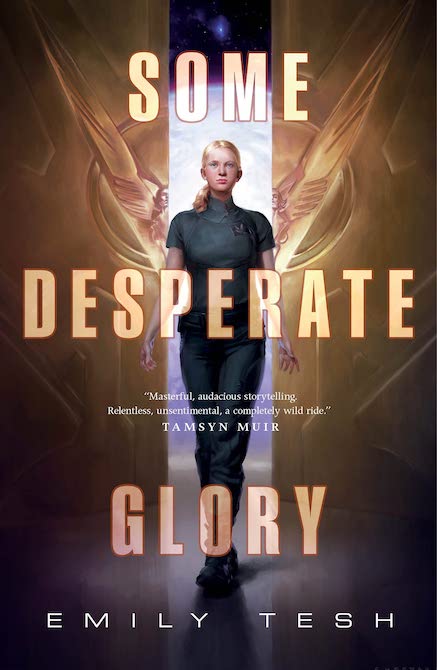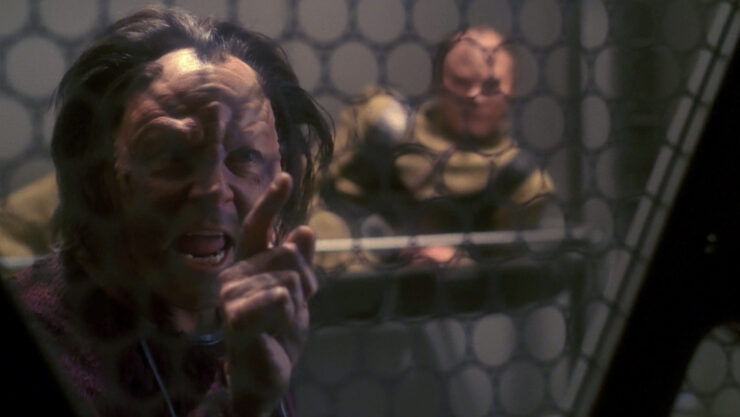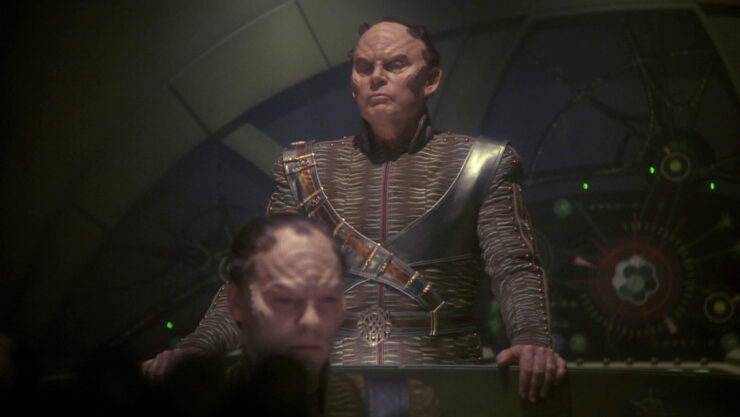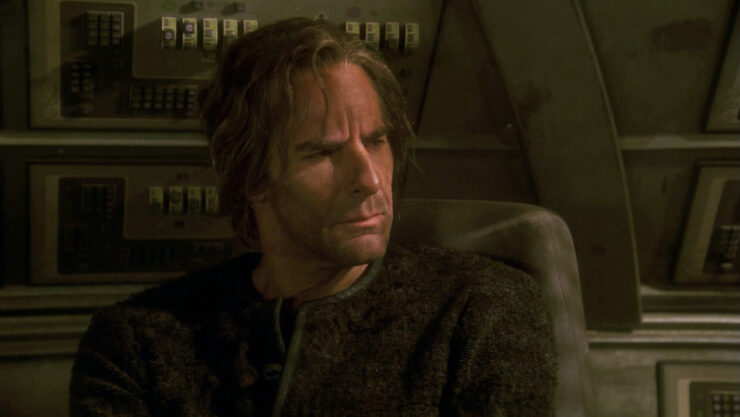“Stratagem”
Written by Terry Matalas and Mike Sussman
Directed by Mike Vejar
Season 3, Episode 14
Production episode 066
Original air date: February 4, 2004
Date: December 12, 2153
Captain’s star log. Degra wakes up in an unfamiliar shuttlecraft, looking bedraggled and with much longer hair. In the cockpit is Archer, who also has much longer hair. Archer says that they just escaped from a Xindi prison, where they’d been for the last three years. Degra is, to say the least, confused.
Archer explains that they were cellmates. After the Xindi weapon Degra created was successful, Archer was taken prisoner, the Enterprise destroyed. But after Earth was destroyed, the old Xindi rivalries came back out again, and the Insectoids successfully conquered the other Xindi races. Degra was also imprisoned, and the Insectoids thought it’d be hilarious to put Degra and Archer in the same cell. At first they tried to kill each other—Archer points to a scar that is from the first time they fought—but eventually they came to a rapprochement.
After showing Degra their matching prison tattoos, Archer hypothesizes that Degra’s amnesia is due to the bloodworm the Insectoids put inside him for interrogation purposes. It sometimes has that side effect. The bloodworm is still in Degra’s arm, and Archer removes it at the Xindi’s request.
They manage to escape an Insectoid attack and work together to fix a coolant leak. Archer has nowhere to go—his ship and homeplanet are long gone—but they can get Degra to his family. He says they’re at a planet orbiting a red giant, but he doesn’t think they should go there yet, not until they’re sure they’re not being followed.
Buy the Book


Some Desperate Glory
After they settle down for the night, Archer uses a hypospray on Degra and then leaves the shuttle—
—which turns out to be inside Enterprise. It’s not three years later. A flashback informs us that three days earlier, Enterprise returned to the test site from last episode and found Degra’s ship. They incapacitate it and take Degra and his two crew prisoner. The prisoners aren’t talking, and Degra ordered all data deleted from his ship’s computer before the Enterprise crew boarded. Sato manages to retrieve a few things, including a letter from Degra to his family.
Phlox says that, based on his examination of Xindi brain chemistry from the various Xindi he’s been able to examine (including the three prisoners), he can erase their short-term memory. This prompts a notion in Archer. Tucker builds a flight simulator around a modified shuttlepod, Phlox stimulates the hair growth of both Archer and Degra, creates the tattoos, and injects a Regulan bloodworm (which is harmless) into Degra. The MACOs provide a subcutaneous communicator so they can talk to Archer without Degra knowing. T’Pol helps Archer create a backstory for the pair of them, based on what they know about the Xindi.
They also have to leave the test site area, as the residual radiation from the weapons test is starting to affect Enterprise’s systems.
Mayweather jostles the shuttle around when the sedative wears off on Degra, and Archer tells him that they’re flying through an anomaly. The shuttle they “stole” isn’t lined with trellium-D, so they’re vulnerable to the anomalies. They’re stuck in place, as they can’t risk moving forward with this many anomalies around. This convinces Degra to send out a distress call.
Reed reports to T’Pol that there’s a Xindi ship on approach, about six hours away. Given that the Xindi have superior sensors, T’Pol orders Reed to take them back into the radiation-filled test site area.
Sato responds to Degra’s distress call, disguising her voice as that of Thalen, one of the other prisoners, saying that he’s safe on Azati Prime. (One of Degra’s letters to his family mentioned that he visited there recently.) Degra asks if his wife is still there, and Sato says yes. The communication line goes dead before Degra can ask any further questions, but Degra inputs the coordinates for Azati Prime into the navigation computer—and encrypts them, as he still doesn’t entirely trust Archer.
However, T’Pol and Sato decrypt the coordinates and find that Azati Prime is a) in orbit of a red giant, so is likely the right spot (especially since Degra went to the trouble of encrypting) and b) three weeks away at maximum warp, so they’d better be damn sure it’s the right place.
The radiation in the test site messes with the simulator, and the image outside the window flickers. Degra sees this, and starts to quiz Archer, asking the names of his children. Sato feeds him that from the letter home, but then Degra asks which one is older. He hesitates—even though he’s got a 50-50 shot at guessing right—and that’s enough for Degra. Luckily, T’Pol and Sato are watching on a security camera and they’ve already warned Archer that Degra is about to attack him with a knife.
They put Degra back in the brig. They can’t do another simulation, not with that Xindi ship looking for them (and which will be searching for Degra once they discover he’s not there), and Tucker hasn’t been able to dope out the Xindi vortex technology. Archer asks for all his data on it.

We cut to Archer ordering T’Pol to engage. The ship starts to shake a lot. Archer goes to the brig and brings Degra and Thalen to Tucker. Archer says that they’ve adapted the vortex technology to their engines, but something’s gone wrong and Tucker needs help stabilizing it. Degra orders Thalen to do nothing. But then the ship stops shaking, and Tucker checks his console, discovering that Mayweather inverted the warp field, and that did the trick.
Archer orders Thalen taken back to the brig, while he brings Degra to the bridge. Azati Prime is on the viewscreen, to Degra’s shock and horror. He cries out that Enterprise will never get at the weapon, as they’ll never get past the planetary defenses.
That’s all Archer needs. He switches the viewer back to what’s actually out the window: the test site. They never left, Mayweather just shook the ship and they put an image of Azati Prime (presumably from the reconstructed Xindi database) on the screen.
They do the memory-wipe thing on all three Xindi and put them on Degra’s ship, faking a plasma leak to explain their falling unconscious. Then they set course for Azati Prime, leaving Degra to be found by his fellow Xindi.
Can’t we just reverse the polarity? Apparently the Xindi subspace vortices use “some kind of phase deflector pulse,” whatever that means.
The gazelle speech. Archer does a very good job of pretending to be Degra’s comrade in arms after a three-year prison bit. He only betrays how much he dislikes Degra after the jig is up.
I’ve been trained to tolerate offensive situations. T’Pol masterfully runs the deception from the command center.
Florida Man. Florida Man Builds Awesome Flight Simulator Out Of Spare Parts.
Optimism, Captain! Phlox is able to erase short-term memories of Xindi Primates because if he couldn’t the plot wouldn’t work.
Better get MACO. The MACOs use subcutaneous communicators, one of which Archer borrows for the deception. You gotta wonder why everyone doesn’t use those…
I’ve got faith…
“You gave us the coordinates of a red giant!”
“I gave you what you thought you wanted.”
“I guess I’ll just have to wipe your memory clean again, go back into the simulator, and start this whole thing over.”
“I doubt there’s time for that. We both know my people are searching for me.”
“I think you didn’t figure it out until after the malfunction—I’d be willing to bet those coordinates are real.”
“Then I suggest you proceed there at maximum warp.”
–Archer trying to figure out if Degra gave the right coordinates for Azati Prime, and Degra messing with his head.
Welcome aboard. Only two guests in this one, both recurring characters last seen in “Proving Ground” in the previous episode: Randy Oglesby as Degra and Josh Drenner as Thalen. Oglesby will be back in “Azati Prime,” as will the character of Thalen, who will be played in that episode by Christopher Goodman.
Trivial matters: This episode takes place very shortly after “Proving Ground,” with Enterprise and Degra both returning to the test site of the weapon from that episode. Archer shares one of the bottles of Andorian ale Shran gave him in that episode with Degra on the shuttle. Degra discusses watching the prototype weapons test in “The Expanse.”
Regulan bloodworms were first referenced in the original series’ “The Trouble with Tribbles,” written by David Gerrold. The bloodworms have been used by Phlox for medicinal purposes in previous Enterprise episodes. In his TNG script “Blood and Fire,” which was never produced as a TNG episode, Gerrold had the creatures be disease carriers. (The script was rewritten, with Gerrold’s blessing, as an original series story by Carlos Pedraza for the fan film series Star Trek: New Voyages.)
This is the second story co-written by Terry Matalas, at the time a production assistant, who has most recently been the show-runner of seasons two and three of Picard.

It’s been a long road… “Thanks for your help.” My first instinct—and likely many people’s—upon seeing the opening of this episode was, “Really? Again?” We’d already done the jump-ahead-into-an-alternate-future-where-the-good-guys-lost scenario in “Twilight.” And we know Earth isn’t really going to be destroyed, because we’ve seen it in every other Trek production prior to this (and all the ones since, for that matter).
But they didn’t do that. Instead, they pulled a beautiful Mission: Impossible-style fakeout. The episode is perfectly structured, from the viewers initially going along with Degra in their confusion and belief that three years have passed, then having Archer (and his comedy wig) step out of the simulator.
There are so many things I love about this episode, and not just because I’m a fan of the M:I TV series (among other things, Leonard Nimoy’s landing spot after Trek was cancelled, starring on that show as Paris for two seasons). I like that the crew get information, not by threatening to throw people out of an airlock, but by using actual humane interrogation techniques. (Okay, you can argue that wiping out someone’s short-term memory isn’t that humane…) Yes, it involves trickery, but as anyone who does interrogations for a living can tell you, trickery is a very important part of a good interrogation, especially when the person you’re questioning is hostile.
The episode also proves to be an important step forward for both Archer and Degra, as each learns that the other is a person, not just an abstraction. To Degra, humans are just the people they were told will wipe them out. To Archer, the Xindi are the bastards who killed seven million people. But by the end of this episode, they’ve both come to know each other, and now they know each other as people rather than enemies. Credit to Scott Bakula and especially Randy Oglesby, who really sell the characters’ tentative, hesitant, inconsistent steps toward understanding.
Every war throughout history has ended when people stop fighting and sit down and talk to each other. This is the first time—well, second, really, following “The Shipment”—that Xindi and human have sat down and talked to each other, and for all that it’s part of a deception, it’s a critical component to the possibility of peace.
What really makes the episode shine for me is that second fakeout at the end. Because it’s just like Star Trek to go for a technobabble problem at the climax, and it turns out to be another clever trick on Degra.
Contrary to the tiresome macho expectations of “The Expanse,” our heroes are being smart and proactive and clever and not violent assholes who are doing, as Archer said, “whatever it takes.” I particularly like that all our regulars have a role in the deception, even the oft-neglected Mayweather, whose piloting skills are critical to making the both simulations convincing, as well as the not-quite-as-neglected Sato, whose skills are equally critical.
Just an excellent episode that puts a face on the enemy and allows our heroes to be heroes again.
Warp factor rating: 10
Keith R.A. DeCandido will be an author guest at HELIOsphere 2023 this coming weekend in Piscataway, New Jersey. Check out his schedule here.










